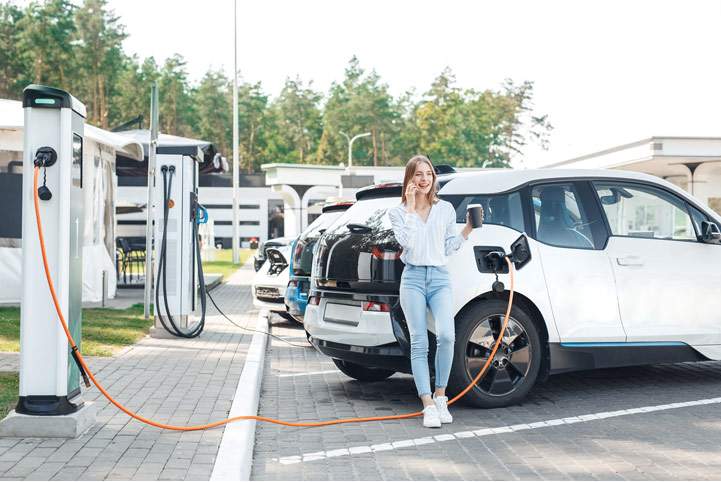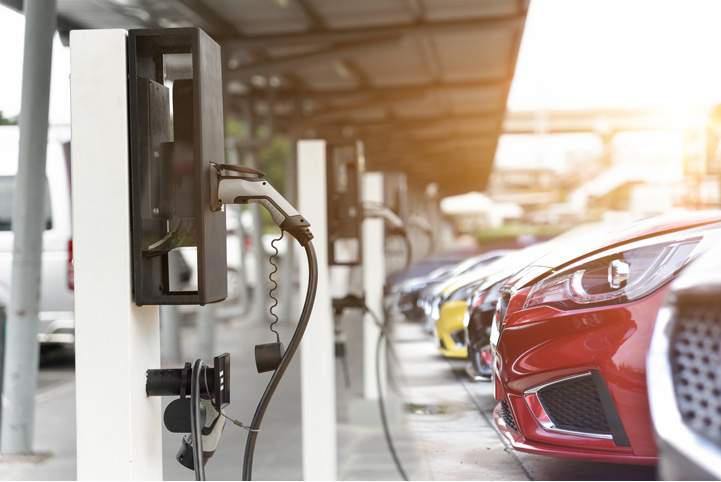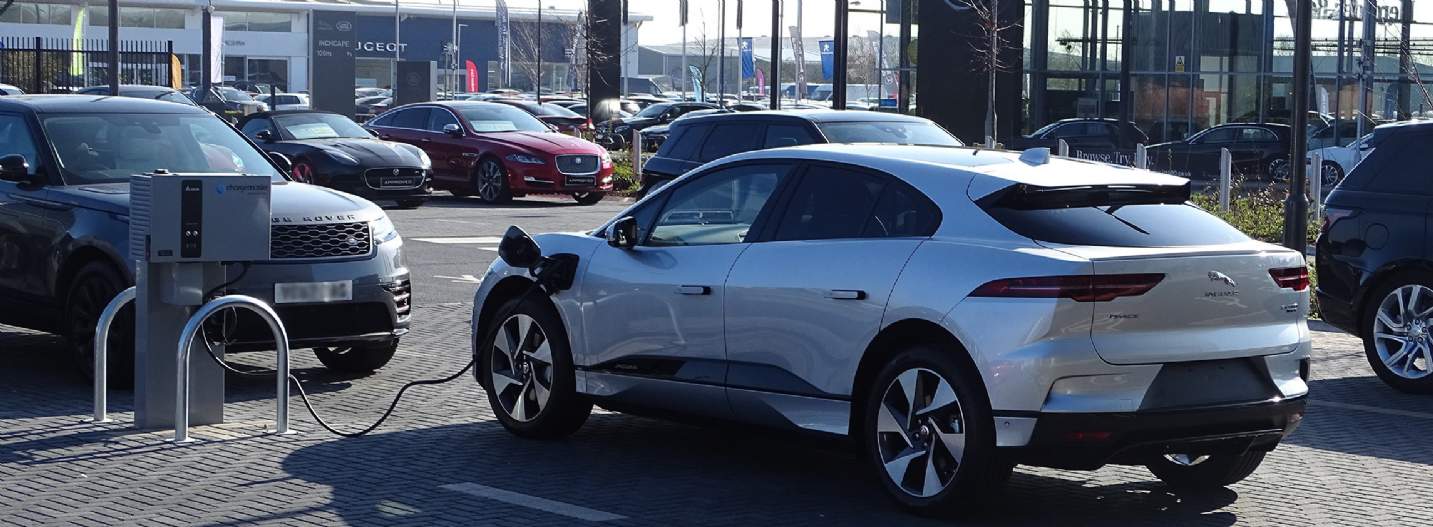With electric vehicle charger rollout out of kilter with the government's 2030 targets, there is a huge opportunity for landlords to contribute to the future of zero-emission mobility in return for rental income, increased footfall and enhanced ESG credentials to their assets
When was the last time you planned where you are going to fill your car up with petrol?
Consciously thinking about refuelling your internal combustion engine vehicle ultimately comes down to the cost of petrol and diesel. It is not a case of where or when, drivers are confident they are in the vicinity of a petrol filling station and they know there will be a pump available immediately or within five minutes of arrival.
Presently, zero emission mobility is a little trickier. If you drive a Battery Electric Vehicle (BEV), you are in the 5% minority of the 34 million cars navigating the UK road networks and you may need to plan a bit more meticulously. According to Which?, 74% of those using public charging infrastructure are dissatisfied and 48% of drivers express difficulty in finding a functional charging point.
The number of those driving BEVs is swiftly rising, with an expected anticipated 19.7% new electric car sales market share in 2023 and by 2030, which is a landmark year when the sale of new internal combustion engine (ICE) vehicles will be banned, the projected number of BEVs on the roads will have increased to 10 million, as forecasted by the Society of Motor Manufacturers and Traders (SMMT).
To facilitate growth, the UK government estimates that tenfold expansion will be required by 2030 with 300,000 public charging locations needed. One SMMT modelling exercise suggests that the actual number of individual chargers needed sits somewhere between 689,000 and 2.3 million, but this figure is widely debated. This desperate call for public charging infrastructure largely arises due to an estimated 40% of EV drivers not having dedicated off street parking for home charging, albeit these people typically live in major cities and are less likely to own an electric vehicle. In 2022, 62 new EVs were registered per every new charging point installed, a statistic that evidences the off-pace rate of charger rollout.
The drivers of change
The government ban on the sale of new ICE vehicles in 2030 and the UK’s commitment to net zero carbon by 2050 are not the only factors driving change. Other regulation and policy such as Clean Air and Low Emission zones are impacting consumer decisions, as well as improved EV incentives and grant offerings.
Will it cost me less to run an BEV?
The cost of ownership of ICE vehicles is continuously climbing, exacerbated by the cost of unleaded petrol and diesel. On average a petrol car costs around £15 or 15p per mile to travel 100 miles assuming the UK’s 2022 average fuel consumption of 45 miles per gallon and current average fuel prices at 143.97p per litre. According to EDF, the average UK electricity price is sitting around 34p per kWh and assuming an EV will on average travel 3.5 miles per kWh, driving 100 miles would cost £9.71 or 9.71p per mile when charging your vehicle at home. Public charging operator PodPoint estimate that a rapid charge costs around £20 or 20p per mile for a 100-mile charge in 20 minutes. Whilst emergency “en-route” rapid charging is currently more expensive than stopping at a petrol station, 80% of EV charging is conducted at home, and drivers must carefully plan to do so. ICEs notoriously require more servicing and induce higher tax rates (EVs are free to tax). Although EVs are somewhat more expensive to buy initially with demand pushing up prices, Peugeot and MG have now released affordable models below £30,000 and it is expected that other OEMs will follow suit. Typically those purchasing EVs are older and wealthier, have another ICE vehicle and a house with off street parking. Finally, there are increasing clean air and congestion charges, particularly for older ICE vehicles, and these are set to increase as the clock to 2030 ticks down.
In tandem with the economic benefits received by the EV consumer, many people are considering flocking to EVs for their own carbon footprint consciousness. UK census data shows that over half of motorists between the age of 16 and 49 years say they are likely to switch to all electric vehicles within the next decade, many citing their personal sustainability goals as the reason for conversion. Equally, most EV drivers currently have access to off street car parking due to a correlation between house price and the affordability of EVs. In cities, on street charging should be dedicated and have more convenient tariffs.
Range anxiety is often flagged as a major concern for those looking to switch to electric. However recent research by Nissan would suggest that owners of EVs across Europe are driving more miles annually than those in petrol and diesel cars. Vastly improving vehicle and charging technology is dispelling myths that EV range will halt progression. IONITY, a public charging operator funded by the major motor manufacturers such as BMW and Daimler Group, Ford and Hyundai, have produced a 350 Kw ultra-rapid charger which can charge 200 miles in just 30 minutes, challenging the speed of Tesla’s superchargers. This progression is equally reflected in German vehicle technology as the Mercedes EQS 450+ model takes the current top spot with a 485-mile range, outrunning the Tesla Model S. With Original Equipment Manufacturers (OEMs) consistently expanding their EV model range and new entrants such as Ferrari coming to the market with their first EV in 2025, technology and infrastructure is only going to improve.
How do we facilitate growth?
Meeting required infrastructure targets undoubtedly generates a number of challenges. The charging point operator (CPO) market is highly contested, with approximately 25–30 key players competing over electricity supply and sales to EV consumers. To provide an optimal user experience, these players are required to create a uniform roaming network for charging. This enables consumers to use a variety of charging points from different operators, despite being a customer of only one provider. Bi-lateral peer-to-peer roaming contracts in a competitive market enables providers to control the market hand-in-hand and pursue greater profit margins, which can lead to increased roaming charges for consumers unless they know which providers are in bed together. The UK public charging market is still relatively immature, and once more regulation is established and the number of operators consolidates, a more centralised roaming network will benefit both providers and consumers. Some of the early pioneers are now running out of capital, and whilst there is substantial equity funding coming to the UK, absorption and consolidation is expected.

Grid capacity challenges remain a constant geographical threat to certain sites and locations. CPOs identify opportunity sites by using artificial intelligence technology to assess traffic flow and popular destination routes navigated by EV drivers. The CPO is required to make an application to the Distribution Network Operator (DNO) for permission to tap into the grid. A minimum grid capacity of 800 kVA is required for a small hub between 8–12 rapid charging points with the intention of expanding further, and if a grid upgrade is required then the DNO will provide a cost to the CPO, usually within six weeks of the application. The total cost generally fluctuates between £400,000–£500,000 with the new connection averaging around £100,000 with the add-on of installation and equipment all of which is incurred by the CPO. The DNO may also require the CPO to future proof the grid at a further cost, which can make some sites and locations unviable for CPOs. More local engagement between local authorities, DNOs and CPOs is required in order to create viable sites.
Supply chain issues are causing delay to electrified power unit production, mainly as a result of battery raw material shortages such as lithium as well as semi-conductor chip shortages plus manufacturing delays and problems arising from Covid-19 lockdowns. Vehicle availability and supply is not currently matching demand which is notching up pricing as OEMs attempt to ramp-up production. This is anticipated to be a short-term challenge and supply is expected to stabilise. Ford have recently invested £230 million to transition their existing transmission facility in Halewood, Liverpool, in anticipation of this stabilisation and increased production of electrical power units for EVs.
Charger rollout is slow-paced and unevenly distributed at present, clustering mainly in the south east where there is the highest concentration of EV drivers. There are more public chargers in Westminster than there are in the West Midlands, and distribution needs spread more evenly across the nation to meet future demand. It is often the case that land owners are not accustomed to the benefit of opening up space to CPOs for their public charging points.
What are the opportunities for property owners?
An EV charging hub is defined as a site or location with more than six EV chargers. There are three types of public charging hub locations:
The best performing charging hubs are en route and destination as they often have the three crucial amenities to support EV drivers whilst their car is charging:
Landlords who provide these amenities on their sites, whether they are retail parks, PFS, supermarkets, office blocks, or even car dealerships should be considering the benefits of establishing a public charging hub within their site if they can secure a grid connection.
Returns are increasing and are often location dependent but rents are currently tending to range between £2,000–£4,000 per charger per annum in rental income with index linked uplifts cap and collared at 1–3% for a 20–25 year term normally. This is a drastic improvement on earlier returns a couple of years ago, with evidence of some rents reaching £5,000 per charger per annum in strong locations. Over the term of the lease, landlords could expect a return between £900,000 and £1,250,000 for 8–15 car parking spaces (EV charging points generally take up four car parking spaces for every three chargers).
Other lease structures exist, with some CPOs offering a base rent of £1,000–£1,500 per annum per charger with index linked 1–3% plus a 10–15% gross profit share. According to a market leading CPO Osprey Charging Network, charging hubs achieve 14 charges per charger per day on average, although performance data suggests that the best sites are achieving 20 charges per charger per day. The CPO turns over between £9–£19 per charge based off the sale of electricity. In order to calculate the gross profit, the CPO would subtract the cost of purchasing the electricity from the DNO plus initial instillation and upgrade costs and minor operating costs such as customer payment software. Whilst landlords inherit a performance-based risk, at the rate the EV consumer market is expanding, this could be a more fruitful structure for strong performing sites if the CPO has an annual turnover of over £1 million per site.
Other key benefits include an upgraded site power capacity at virtually zero cost to the landlord, as well as increased footfall to their site, generating “new to industry facilities” revenue from the supporting amenities. Norway is a mature EV market and is estimated to be five years ahead of the UK market. Research and evidence suggest that on Norwegian retail park schemes with EV charging hubs footfall has increased by 200 visitors per day. Moreover, if landlord owns development land and are looking to build out a scheme, local authorities will now often require EV charging in order to obtain planning consent, and by introducing a CPO, developers can obtain this element at minimal cost. Finally, EV charging add undoubted environmental, social and governance (ESG) credentials to property with it’s contribution towards carbon zero enhancing marketability and value.

How can Savills help?
